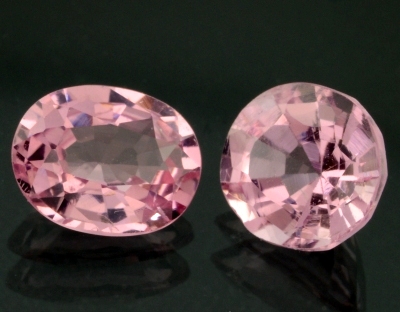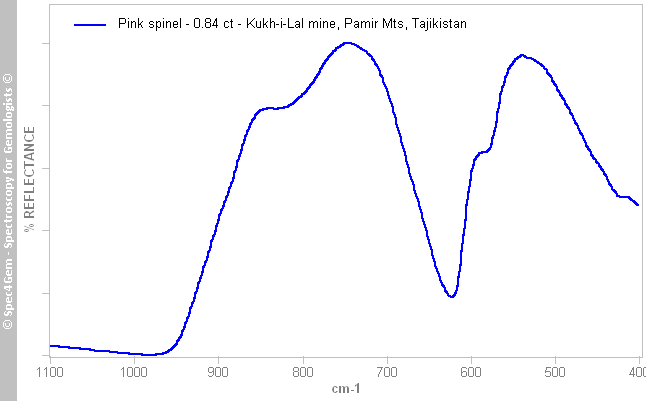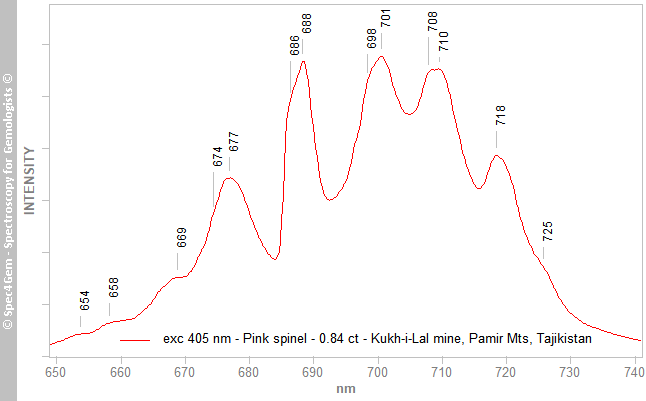Pink spinel from Kukh-i-Lal, Pamir Mountains, Tajikistan
- Details
- Created: Friday, 13 October 2017 20:55
The Kukh-i-Lal mines (formerly the ‘Badakhshan ruby mines’) are located in what is today Tajikistan. Up to the end of the 20th century, little was known about these mines located in a closed area of the then-Soviet Union. Discovered following a 7th century earthquake, the Kuh-i-Lal mines were the world’s main source for famous spinels, located on the Silk Road linking Europe with Asia. After the Soviet Union collapsed and the end of Tajik civil war, the Tajik spinels reappeared in the market.
This mine is known to be the mine where no ruby is found along with the spinels, although they generally do coexist. They are generally pink in color with the saturation increasing with stone depth.
The two faceted stones of 0.84 and 0.93 ct studied in this report are shown in figure 1, not perfectly cut but an interesting color!
 Figure 1. The 0.84 and 0.93 ct pink spinel from Kukh-i-Lal, Tajikistan.
Figure 1. The 0.84 and 0.93 ct pink spinel from Kukh-i-Lal, Tajikistan.| Shape | oval and almost round |
| Size |
6.6 x 5.2 x 3.1 mm (oval) & Ø 6±0.2 x 3.7 (round) |
| Color | pink |
| Lustre | vitreous |
| Weight | 0.84 ct (oval) & 0.93 ct (round) |
| SG | 3.69 (oval) & 3.72 (round) |
| RI | 1.714 (oval) & 1.715 (round) |
| DR | not applicable |
| Pleochroism | not applicable |
| Polariscope / Conoscope | some strains (moving black shadows) -> anomalous double refraction |
| SWUV | inert |
| LWUV | moderate red |
| Magnetic susceptibility N52 | inert |
| Chelsea filter | pink |
Table 1. Observational and measured properties
Infrared reflectance spectroscopy:
The IR reflectance spectra were acquired from the table of the two stones, the material being isotropic, the spectrum is not lattice directions dependent. The spectrum of the 0.84 ct spinel is shown in figure 2, that of the 0.93 ct spinel is not displayed since there is no difference compared to the 0.84 ct stone's one. The spectra are characteristic of natural spinel (synthetic verneuil spinel's spectrum significantly differ with an extra band at 940 cm-1 and the flux-grown synthetic spinel has a spectrum fully comparable with the natural spinel, therefore indistinguable with this method).
 Figure 2. The IR reflectance spectrum of this 0.84 ct spinel shows a characteristic spectrum of natural spinel.
Figure 2. The IR reflectance spectrum of this 0.84 ct spinel shows a characteristic spectrum of natural spinel.UV-VIS-NIR spectroscopy:
The spinel being an isotropic material does not require particular care for acquiring the spectrum. The UV-Vis-NIR spectra of the two stones were acquired with the light path perpendicular to the stone's table and entering the stone through the culet. The spectra are very similar, thus only one is shown in figure 3, this is that of the 0.84 ct spinel.
 Figure 3. The UV-Vis spectrum of the 0.84 ct spinel shows two broad bands at 388 and 538 nm, a hump at 419 nm and a small feature at 478 nm, all related to Cr3+. The 687, 699 and 708 nm small features are Cr3+ photoluminescence emissions (pertaining to the spectrophotometer technology).
Figure 3. The UV-Vis spectrum of the 0.84 ct spinel shows two broad bands at 388 and 538 nm, a hump at 419 nm and a small feature at 478 nm, all related to Cr3+. The 687, 699 and 708 nm small features are Cr3+ photoluminescence emissions (pertaining to the spectrophotometer technology).The spectrum shows two characteristic broad bands at 388 and 538 nm that are due to the presence of Cr3+ in the lattice structure. These features are well-known and result from the spin-allowed 4A2 → 4T1 and 4A2 → 4T2 transitions. The hump at 419 nm is related to the Cr3+ spin-forbidden transitions. The very small feature at 478 nm is possibly attributed to Fe3+ (6A1g → 4A1g). The features at 687, 699 and 708 nm are the commonly called 'organ-pipe' emission bands that can also be observed with a hand-held spectroscope. These photoluminescence emissions are visible in the absorption spectra because of the spectrophotometer technology that uses a CCD and a full range UV-Vis-NIR light source. This will not occur with a spectrophotometer using a monochromator on light source end-side.
The spin-allowed 4A2 → 4T2 transition band is located at 538 nm, such position tends to indicate the spinel stone was not heated above 800° C. This band shifts to 542, 545 nm or even more if the spinel was submitted to heat.
Photoluminescence spectroscopy:
As seen in the UV-Vis-NIR spectrum (figure 3), Cr3+ photoluminescence emissions are just visible with a simple halogen light source. Using SWUV or a 405 nm laser should be quite easy to excite the Cr3+ luminescence. The spectrum of the 0.84 ct spinel (figure 4) acquired with a 405 nm laser shows the Cr3+ strong red luminescence with its so characteristic 'organ-pipe' structure. The same zoomed-in spectrum is presented in figure 5 to focus on Cr3+ emission's spectral range.
 Figure 4. The 0.84 ct spinel photoluminescence spectrum with excitation at 405 nm shows the so characteristic 'organ-pipe' spectrum known to most of gemologists.
Figure 4. The 0.84 ct spinel photoluminescence spectrum with excitation at 405 nm shows the so characteristic 'organ-pipe' spectrum known to most of gemologists.The main emission at 686, 688 nm is related to the R-lines (R1 and R2, splitting may not be observed), the ZPL (Zero Phonon Line) and the LPM (Lattice Phonon Modes). Others emissions are also known as the R and N side bands. Separating the R lines from each other, the R lines from the ZPL and LPM requires a very high resolution and properly calibrated spectrophotometer as the ones used in Raman spectrophotometer and to operate at low temperature such as LNT (Liquid Nitrogen Temperature). The R-lines are separated by just a bit less than 2 cm-1 that is only 0.09 nm, the ZPL from R1 is about 5 cm-1 thus 0.23 nm. All emissions in spectrum of figure 5 are in fact composed of 3 to 5 emission lines that cannot be resolved with a spectrophotometer with a resolution of 0.7 to 1 nm.
The interesting feature is the ZPL / R-lines, according to their position, usually between 684.2 and 685.2 nm, here nearly 686 nm, indicates the spinel is not heated nor a synthetic one (verneuil and flux-grown). Even if the lines cannot be resolved, each emission group (675-677, 686-688, 698-701, 708-710 and 718 nm) is well defined and quite distinct from others. In synthetic spinels and heated ones, they are all present but much less distinct than in this case. The scale of the figure 5 spectrum makes them looking packed down.
 Figure 5. The zoomed-in photoluminescence spectrum of the 0.84 ct spinel restricted to the Cr3+ emissions range. The main emission at 686, 688 nm is related to the R-lines, the ZPL (Zero Phonon Line) and the LPM (Lattice Phonon Modes). Others emissions are also known as the R and N side bands. The interesting feature is the ZPL / R-lines, according to their positions, nearly 686 nm, indicates the spinel is not heated nor a synthetic one (verneuil and flux-grown).
Figure 5. The zoomed-in photoluminescence spectrum of the 0.84 ct spinel restricted to the Cr3+ emissions range. The main emission at 686, 688 nm is related to the R-lines, the ZPL (Zero Phonon Line) and the LPM (Lattice Phonon Modes). Others emissions are also known as the R and N side bands. The interesting feature is the ZPL / R-lines, according to their positions, nearly 686 nm, indicates the spinel is not heated nor a synthetic one (verneuil and flux-grown). Conclusion:
All data (classical gemology and spectroscopy) are consistent with unheated natural spinel. The pink color is caused by Cr3+ as the main chromophore.

